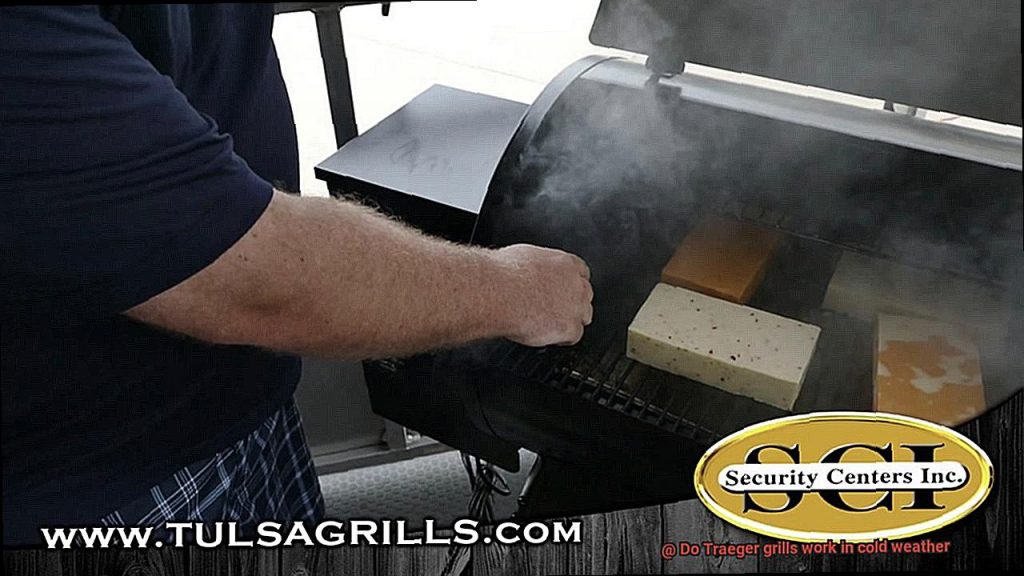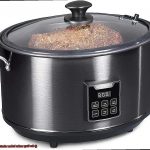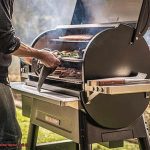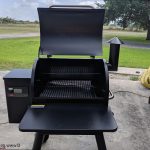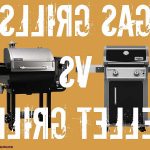Winter is upon us, and it’s time to get those fires burning and start cooking up a storm. But for those of us who are passionate about outdoor grilling, the cold weather can be a real buzzkill. The big question on everyone’s mind is whether Traeger grills work in cold weather. After all, these grills are an investment, and you want to make sure they can deliver the goods even when the temperature drops.
If you’re a proud owner of a Traeger grill, you’re in luck. These grills are known for their reliability in all kinds of weather conditions, including freezing temperatures. Unlike traditional gas or charcoal grills that struggle to maintain heat in cold weather, Traeger grills use wood pellets that burn efficiently and keep the temperature steady.
But what does this mean for your winter grilling experience? It means you can expect juicy, tender results every time you fire up your Traeger grill – whether you’re smoking a brisket or searing some veggies. With consistent heat comes consistent flavor, so you can impress your guests with perfectly grilled meals regardless of how chilly it is outside.
So don’t let the cold weather put a damper on your outdoor cooking plans – grab your Traeger grill and get ready to cook up some winter magic.
Contents
What is a Traeger Grill?
These wood pellet grills use compressed sawdust as fuel, imparting a unique flavor to your food that is hard to replicate with gas or charcoal grills.
Invented in 1986 by Joe Traeger, these grills have come a long way since their inception. Today, they are sophisticated machines equipped with advanced features such as digital controllers that allow you to set precise temperatures and timers for your cooking needs. This means you can achieve perfect results every time, whether you’re cooking a steak to medium-rare or slow-roasting a pork shoulder.

One of the standout features of Traeger Grills is their ability to operate at a wide range of temperatures. You can use them for low and slow cooking as well as high-temperature searing, making them ideal for cooking a variety of foods like meats, vegetables, and even desserts. Plus, the unique fan system circulates heat and smoke throughout the cooking chamber, ensuring even cooking and an authentic smoky flavor.
But what about using Traeger Grills in cold weather conditions? While they’re designed to work in all seasons and temperatures, there are a few tips to keep in mind. Preheat the grill for at least 15-20 minutes before adding any food, store your pellets in a dry place, and consider using a thermal wrap around the hopper to keep them warm. And don’t forget to keep an eye on the temperature throughout the cooking process, adjusting it as needed.
Can Traeger Grills Work in Cold Weather?
There are some essential factors to keep in mind to ensure that your grill performs optimally when the temperature drops.
One of the primary issues that you may encounter when using a Traeger grill in cold weather is that it may take longer for the grill to reach and maintain the desired temperature. Cold air can cause pellets to burn more slowly, resulting in a lower temperature inside the grill. To combat this issue, it is recommended that you use high-quality pellets specifically formulated for use in colder temperatures. These pellets burn more efficiently and help maintain a consistent temperature inside the grill.
Furthermore, wind can significantly affect the performance of Traeger grills in cold weather. It can cause heat to escape from the grill more quickly, making it harder to maintain a consistent temperature. One way to counteract this issue is by positioning your grill in a sheltered location, such as against a wall or under a covered patio.
Apart from these factors, it’s vital to keep your Traeger grill clean and well-maintained during cold weather. Regularly removing any ash or debris from the grill and ensuring all components are functioning correctly will help maintain optimal performance levels.
Preheating Tips for Cold Weather
Grilling outdoors is a delightful activity that you can relish all year round. However, cooking in cold weather requires some extra care and attention. To ensure that you get the most out of your Traeger grill and cook your food evenly and thoroughly, here are some preheating tips for cold weather.
Cleanliness is vital for the proper functioning of your Traeger grill. Therefore, before preheating, make sure that your grill is clean and free of any debris. This will help distribute the heat evenly throughout the grill and prevent any hot spots.
In colder temperatures, it can take up to 20-30 minutes for the grill to reach the desired temperature. Therefore, plan accordingly and give yourself plenty of time to preheat the grill. Be patient as it may take longer than usual to reach your desired temperature.
Keeping the lid closed while preheating is essential as it traps the heat inside the grill and prevents it from escaping. Frequent opening of the lid can cause temperature fluctuations and make it harder for your Traeger grill to reach and maintain the desired temperature.
If you’re still having trouble getting your Traeger grill up to temperature in cold weather, consider using a thermal blanket or insulation jacket. These accessories are designed to trap heat inside the grill and speed up the preheating process.
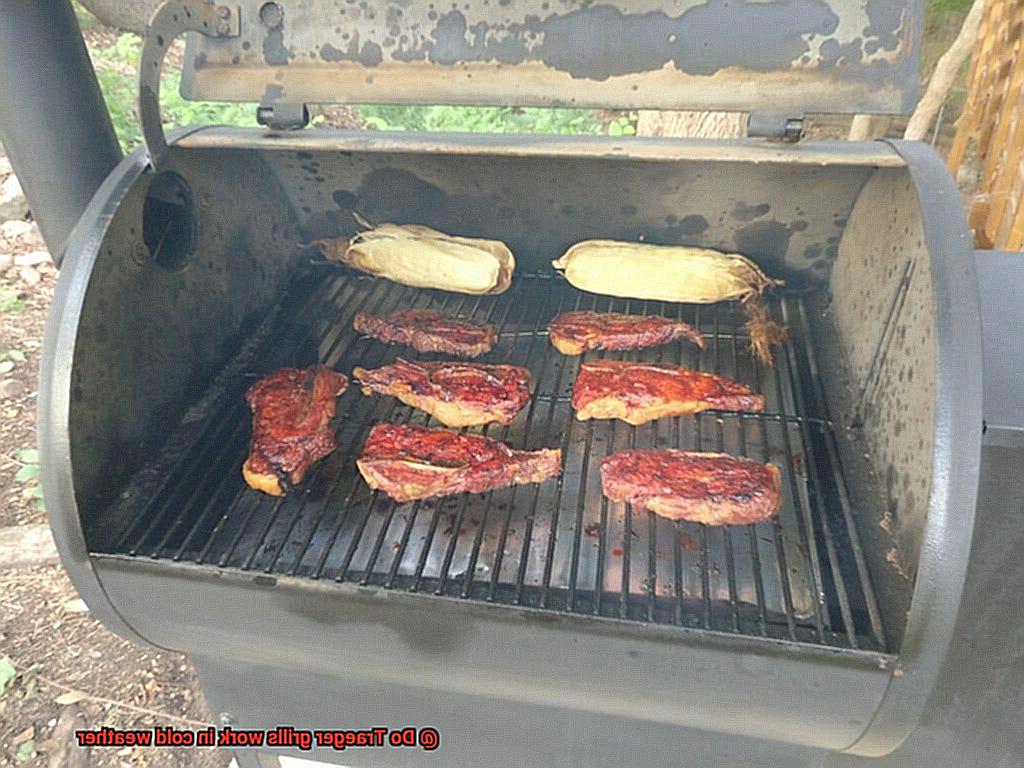
Pellet Storage and Temperature Considerations
As a dedicated griller, you know that the weather can sometimes put a damper on your plans. However, with the right preparation and understanding of pellet storage and temperature considerations, you can keep your Traeger grill running smoothly even in cold weather.
Pellet storage is a crucial factor to consider. Moisture is the enemy of pellets, and damp pellets can lead to frustrating cooking results. Therefore, it is recommended to store your pellets in a cool, dry place like a garage or shed. This will ensure that they remain in good condition and are ready to use when you need them.
Another important consideration is temperature. When temperatures drop below freezing, pellets may become harder and more difficult to ignite. To avoid this, it is crucial to keep your grill covered and protected from the elements as much as possible. Preheating your grill for a longer period of time can also help bring the temperature up and ensure that the pellets ignite properly.
Moreover, the quality of the pellets you use can impact their performance in cold weather conditions. High-quality pellets have less moisture content and are made with denser wood, making them better suited to withstand colder temperatures. Different types of wood pellets also have varying burning temperatures, so it may be worth experimenting with different types to find the best option for your specific cold weather grilling needs.
Adjusting the Temperature Setting
Adjusting the temperature setting is crucial to achieving the perfect cook, especially in cold weather. Traeger grills are designed to operate between 180-450°F, but when temperatures drop below freezing, adjustments must be made to ensure optimal efficiency.
To begin, consider the type of pellets you’re using. Traeger grills use wood pellets as their primary fuel source, and different types of pellets burn at different rates and temperatures. For instance, hardwood pellets burn hotter and longer than fruitwood pellets, which may result in lower temperatures on the grill. Therefore, it’s important to choose the right pellet for your desired cooking temperature to achieve the best results.
Additionally, it’s essential to think about the placement of your grill in cold weather conditions. Wind and precipitation can cause temperature fluctuations on the grill, which can affect cooking times and results. To avoid this, position your Traeger grill in an area that is protected from wind and precipitation. This will help retain heat and increase overall efficiency.
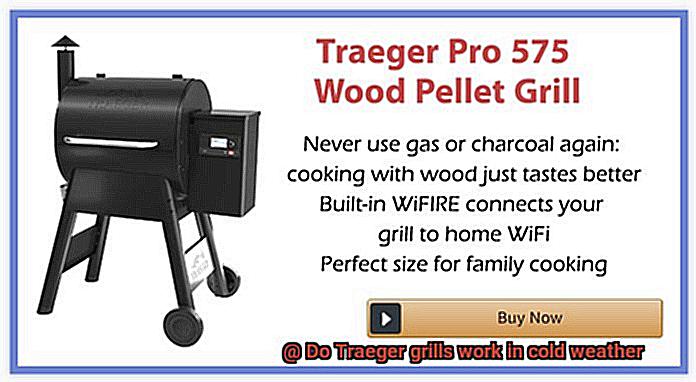
When adjusting the temperature setting on your Traeger grill in cold weather, preheating is a crucial step. Allow for a longer preheat time than usual to ensure that the grill reaches its desired cooking temperature and maintains it throughout the cooking process. Additionally, you may need to make adjustments periodically during cooking to account for any fluctuations caused by changes in weather conditions.
Benefits of Using a Traeger Grill in Cold Weather
If so, you’ll be pleased to know that using a Traeger grill in cold weather can offer several benefits that will make your outdoor cooking experience not only possible but also enjoyable.
Firstly, Traeger grills use wood pellets as fuel, which produces a consistent heat source, even in cold temperatures. Unlike gas grills, Traeger grills don’t struggle to maintain a steady temperature. This means you can cook your food to perfection without worrying about any temperature fluctuations. With Traeger grills, you can expect reliable and consistent heat in all weather conditions.
Secondly, the wood pellets used in Traeger grills produce a natural smoke flavor that can enhance the taste and tenderness of your food. And who doesn’t love that delicious smoky flavor in their food? In cold weather, it’s especially important to use a grill that can add flavor to your meats. The low and slow method of cooking with a Traeger grill not only adds flavor but also makes meats tender and juicy, leaving your taste buds wanting more.
Thirdly, using a Traeger grill in cold weather can be more cost-effective than using a gas grill. Wood pellets are often less expensive than propane or natural gas, making it an affordable option for outdoor cooking enthusiasts who want to keep their costs low. So not only do you get to enjoy cooking outdoors in colder weather, but you also get to save some money while doing it.
Lastly, Traeger grills are designed to be durable and withstand harsh weather conditions. They are constructed with high-quality materials that can handle extreme temperatures without rusting or corroding. This means that you can use your Traeger grill year-round, even in colder climates without worrying about damage or wear and tear. You won’t have to worry about buying a new grill every season when you invest in a Traeger grill.
Common Issues with Using a Traeger Grill in Cold Weather
From maintaining consistent temperatures to ensuring proper pellet performance, here are some tips to help you overcome these challenges and enjoy delicious grilled meals all year round.
One of the most significant issues when using a Traeger grill in cold weather is maintaining consistent temperatures. Fluctuations can occur due to the colder ambient temperature, making it challenging to keep the desired temperature steady. To combat this, try using insulation blankets or windbreaks to help maintain a stable temperature.
Another issue that can arise in cold weather is that it may take longer for your Traeger grill to heat up. The grill’s internal components need to work harder to reach and maintain the desired temperature, resulting in longer preheating times before you can start cooking. To avoid this, preheat the grill for a more extended period and keep the lid closed as much as possible to maintain heat.
In addition, cold weather can impact the performance of your grill’s pellets. Traeger grills use wood pellets as fuel, and when exposed to cold temperatures, they can become damp or even frozen. This can cause them to burn less efficiently or even stop burning altogether, resulting in temperature fluctuations and uneven cooking. To prevent this, store your pellets in a dry place and keep them covered until needed.
Finally, extreme cold temperatures can cause damage to specific parts of your Traeger grill, such as electronic control boards or auger motors. It’s essential to protect your investment by covering it when not in use or storing it indoors during the offseason.
tBGYm4-7h0o” >
Conclusion
In conclusion, Traeger grills are the ultimate solution for outdoor cooking enthusiasts who refuse to let cold weather dampen their grilling game. These grills use wood pellets that burn with maximum efficiency and maintain a consistent temperature, making them the go-to choice in any weather condition. With Traeger grills, you can expect succulent and tender results every time you grill your favorite meats or veggies.
However, it’s essential to keep in mind some crucial factors when using Traeger grills in cold weather. To ensure optimal performance, you may need to adjust the temperature setting and preheat the grill for an extended period. Additionally, it’s critical to store your pellets in a dry place and protect your grill from the elements.
Despite these challenges, using a Traeger grill in cold weather offers several benefits that make it worth the extra effort. For one thing, you get to enjoy that natural smoky flavor year-round without having to worry about propane or gas tanks running out. Plus, Traeger grills are incredibly cost-effective and durable; with proper care and maintenance, they can last for years.
So, don’t let frigid temperatures put a damper on your outdoor cooking fun – grab your trusty Traeger grill and get ready to cook up some winter magic.

